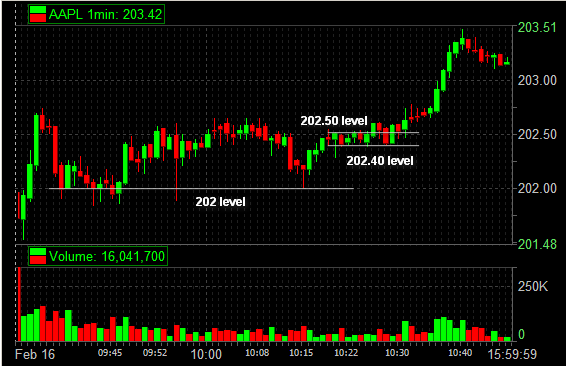I started trading AAPL around 10AM this morning. I noticed it held its small gap from the Open and that each time it was dropping below 202 it would quickly recover. I also noticed that each time it popped above 202.50 that it would fail to hold the bid and drop back down.
My thought process was that AAPL had been strong on Thursday and Friday and since it held the opening gap that it would probably trade higher. I figured that if I could establish an initial position around 202 I had at least two points of upside. At 10:15 AAPL dropped to 202 but was only there for a few seconds. Opportunity lost.
At 10:20 AAPL started to trade between 202.40 and 202.50s. I bid for some stock at 202.42 and got long. I like when stocks start consolidating in a tight range close to their intra-day high. Its usually a sign the stock will trade higher. I also noticed an accumulation program. Each time the bids would get hit around 202.40 AAPL would immediately begin to tick higher.
I made a rookie mistake a couple of times and bought extra shares in the 202.50s. I saw an increase in volume and concluded the buyers had lost their patience and were going to have to bid the stock higher. I was wrong. I dumped most of the extra shares I had bought around 202.48 because I did not want to be caught with a large position if the 202.40 dropped and it quickly traded down to 202.
About five minutes later there was a surge in volume and I caught a one point up move. But I had very little size. Once AAPL clearly started to hold above 202.60 I bid for some more shares but couldn’t get hit. As it moved higher I bid above 202.70 and couldn’t get hit. The buy program was being more aggressive and cutting anyone who was interested in picking up shares on the bid.
This blog is the type of post trade analysis I do every day. I think about each aspect of significant trade I made during the day. I review my rationale for being in the trade and each part of my execution. I ask myself question like “Was I buying at the most favorable prices?”, “Was I aggressive enough?”, “Was I properly controlling my risk?”, “Did I take enough money out of the move?” etc.
The idea is to fire up the synapses and make sure that when a similar trade presents itself in the future I will trade it more effectively. Make this type of post trade analysis part of your game.
And by the way, if you are continually bidding higher for a stock and you can’t get hit its probably going up!


6 Comments on “Its Probably Going Up”
Couldn’t you just execute a market order when you saw the behaviour you stated ( that you couldn’t get hit )
Couldn’t you just execute a market order when you saw the behaviour you stated ( that you couldn’t get hit )
thats not true, many times when they don’t fill you when prices are going higher, its becuz they want you to pay up and then slam it right back down forcing you to buy tops and sell bottoms.
thats not true, many times when they don’t fill you when prices are going higher, its becuz they want you to pay up and then slam it right back down forcing you to buy tops and sell bottoms.
Mr. Spencer I just start reading this blog a week ago, and reading past posts.. I am impressed by your generosity for sharing such valuable lessons/ Ideas, I like your posts and Bella’s post more in this blog. Just thanking you 🙂
it would be easy for Steve to pay the offer when its breaking above 60c, 70c, but what if starts to tick back to 50c then lower? Id wager a large majority of traders would pay the offer in this situation. I think what Steve is trying to show us is that risk mgmt is the most important thing. He dumped most of his shares at 48c to control the risk. You can see if the 40c bid drops how quickly aapl could trade down to 202 (9:55am and 10:15am). I can see for his trading this is the proper way to handle/control the risk. I don’t trade appl so knowing the rhythum of how it trades can be important too. Its easy to look back at a chart and say u would have done this or that, but when ur in the moment its a whole different ballgame.